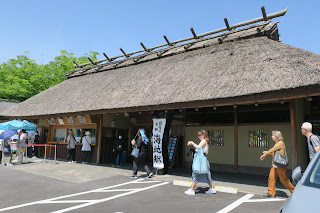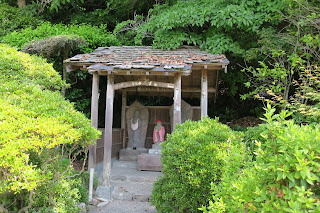Beppu Onsen is an extensive hot spring system in the city of Beppu, Oita,
Japan. There are eight distinct major thermal spring zones called "Beppu
Hatto".
There are rich hot spring resources in Beppu; the volume of water discharged
from the Beppo system is second in volume to that of the Yellowstone National
Park in the Western United States.
There are 2,909 hot spring vents within the city, and these account for more
than 10% of the 27,644 hot spring vents in Japan. Statistics from the Beppu
City Hall show that more than 130,000 tons of hot spring water gushes from the
ground every day. This is the second largest amount of hot spring water
discharge in the world, and the largest amount in Japan.
|
Map of Beppu Onsen.
Beppu is famous for its onsen (hot springs). It has eight major
geothermal hot spots, sometimes referred to as the "eight hells of
Beppu" among many others. Six of these are located close by within in
the Kannawa district up the hill, and two are in the nearby Shibaseki
district down the hill. Beppu is also divided into eight major hot
spring areas known as Beppu Hattō.
-
Some hot springs in the Beppu area are Beppu Onsen, Kankaiji,
Kamegawa, Shibaseki, Kannawa, Myoban, Horita, Hamawaki, among others.
-
In addition, Oniyama Jigoku, known as "monster mountain hell" for the
large numbers of crocodiles bred and kept on the grounds surrounding
this hot spring, is nearby.
|
|
Chinoike Jigoku.
Chinoike Jigoku (literally Blood Pond Hell) is one of the hot springs (onsen) included in the “Jigoku Meguri” tour in Beppu, Japan. These Beppu Hells are a cluster of famous Japanese onsen that are renowned for their unique beauty, and are meant for viewing instead of bathing.
-
Having a history stretching back more than 1300 year ago, Chinoike Jigoku is one of the oldest natural hot spring in Japan. Because of the high temperature of the hot spring’s water, there is no full body bathing. However, you can enjoy free foot baths.
-
It almost goes without saying that the main point of interest of Chinoike Jigoku is its unique appearance; its striking red pigment is as if the hot spring emerged from hell itself. Here, heated red mud containing iron oxide, magnesium oxide, and similar materials spring forth from the depths below the water, and this colors it a vivid red.
|
|
Tatsumaki Jigoku.
Tatsumaki Jigoku is one of the hot springs (onsen) included in the
Jigoku Meguri Tour, in which you can enjoy famous Japanese hot spring
spots all at once. “Tatsumaki” usually means “tornado” in Japanese, but
the meaning in this situation is “geyser.” Let’s see the powerful breath
of the earth first hand.
-
At Tatsumaki Jigoku in Beppu, the geyser erupts every 30 to 40 minutes
and lasts for 6 to 10 minutes. Compared to other geysers in the world,
this eruption cycle is quite short. Although the geyser has the
potential to reach up to 30 meters, they have added concrete to lessen
the blow and make it safer.
-
First, hot water is warmed via geothermal heat underground, turning to
steam. Then, water present in the pipe leading up to the surface is
pushed out to the surface by the build-up of pressure from the water
vapor. As the pressure releases, the steam and water blow out of the
ground, and this is how a geyser works.
|
|
Shiraike Jigoku.
Shiraike Jigoku is famous for being a habitat for tropical fish as it
providing hot spring heat in a heart-shaped pond. In Shiraike Jigoku,
the pond is surrounded by a circular garden.
-
This garden has a Japanese aesthetic that creates a peaceful
atmosphere for you to enjoy. Shiraike Jigoku also has an exhibition of
classical paintings and drawings.
-
It is named “Shiraike Jigoku” because “shiraike” means “white pond” in
Japanese. The hot spring water itself is clear when it gushes out, but
once the water comes into the pond, the temperature and pressure drop
and it naturally turns a pale color. This hot spring mainly contains
sodium chloride, silicic acid, and calcium bicarbonate. This
alabaster-colored, greenish hot spring water changes by climate
conditions. The temperature is approximately 95°C.
-
In Shiraike Jigoku, there are tropical fish tanks that house many rare
and expensive tropical fish. These aquariums use Beppu’s abundant hot
spring heat to provide a comfortable home for these tropical fish. The
water is kept at a temperature of 26°C to 30°C all year round. This is
the only aquarium in Japan that uses hot spring steam for heating.
|
|
Kamado Jigoku.
Kamado Jigoku is one of the hot springs (onsen) included in the “Jigoku Meguri” tour, in which you can enjoy famous Japanese hot spring spots all at once. Long ago in Japan, rice was cooked with a tool called a “kamado.” It is said that the name of this hot spring comes from the fact that rice used to be cooked using the power of its eruptions.
-
Kamado Jigoku is a place where you can experience various hot spring related things without having to enter the water yourself.
- There is a crystal blue hot spring similar to Umi Jigoku.
- There’s a muddy bubbling onsen that is similar to Oniishi Bozu Jigoku.
- You can also find a small Red Hell that looks like Chinoike Jigoku.
- There is also the “Drinking Onsen” which is very rare within Japan, so feel free to take in the hot spring’s smell, drink its waters, and have a new experience! Because the hot spring is very hot, please be careful of burns when drinking the water.
|
|
Umi Jigoku.
Umi Jigoku (or “Sea Hell”) is one of the hot springs (onsen) included in
Beppu Japan’s “Jigoku Meguri” (Hell Tour), in which you can enjoy famous
Japanese hot spring spots all at once. Contrary to the name ‘hell’ by
which the tour is called, the cobalt blue color gives the water a very
beautiful and dazzling appearance.
-
Out of the 9 Hells of Beppu, many consider Umi Jigoku to be the most
beautiful. The water is a truly beautiful cobalt blue, which is rare
even amongst Japanese hot springs. The reason for the blue color of
the water is its naturally high levels of iron sulfate. This means
that it is entirely natural and not a result of artificial coloring.
The color of the water may be a cool blue, but the hot spring’s
temperature is actually 98°C.
-
At Beppu’s Umi Jigoku, the heat that the hot spring provides its
environment makes it fit to grow plants from the Amazon region. In
particular, the masterpiece of the plant life is the royal water lily,
which is so large that younger elementary school students (up to 20
kilograms) can stand on it! From August to early November you can also
enjoy beautiful flowers.
|
|
Oniishi Bozu Jikoku.
Oniishi Bozu Jigoku (Hell of the Monk’s Head) is an ancient hot spring
that pumps out hot gray mud in a way that resembles a monk’s head. After
the Meiji era (1868-1912), this hot spring became known as “Bozu Jigoku”
and became a tourist attraction. It is one of the seven major Jigoku in
Beppu and is located next to the Sea Hell.
-
The hot mud that was scattered over the rich fields long ago due to
volcanic activity under Beppu made it impossible for rice to grow and
people to live securely. This is why local people called it “hell”.
These strange natural phenomena attracted the public’s attention and
visitors began to walk along the paths where hot mud emerged from the
inferno to take a closer look. This exploration of the hells is the
origin of Jigoku Meguri.
-
There are two kinds of hells in this Oniishi Bozu Jigoku. One is the
“hot mud hell” where balls of hot water gush out one after another and
turn into clay mud. And the other is a geyser where smoke consistently
spews out. Another unique phenomena, is that in between the many rocks
on the geyser, natural air spews out of the hell and makes a sound
like snoring. This is referred to as “the snoring of demons”.
|
See also
Source
Location



















































































